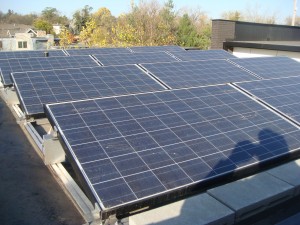Next up: Solar Photovoltaics. The first thing that everyone needs to know about solar energy is that there are two basic types of solar panels: those that provide electricity (photovoltaic panels, or PV), and those that provide heat. They are two entirely different types of panels that work in entirely different ways, with different costs and benefits. So when someone says: “I want solar,” I always clarify which kind first. (“Passive” solar is another type, but that does not involve any equipment.)
For solar electric, there still are several different kinds of panels; they vary mostly in price and electricity production. The all require unshaded space, typically on a roof, and work best when tilted at a 45 degree angle or less toward the south (in the Northern Hemisphere, obviously).
We have 16 solar panels on our roof, 4 of which serve as west-facing awnings that help keep the hot afternoon heat our of my office above the garage. (Since they are flat, at no angle to the sun, they lost about 28% of their productivity compared to having panels angled toward the sun.) Installed in October 2010, they have generated almost 4 megawatts hours (which includes last winter, when they were entirely covered in snow) to date. At 9 cents per kilowatt hour, that equates to a savings of $360 on my electric bill. That’s the worst part about it – electricity is so cheap, that solar gets difficult to justify simply from a financial perspective, unless your rebates and tax credits are really good! But it is also is equivalent to powering 128 average homes for one day, offsetting 2.7 tons of carbon, and planting 70 trees. And that’s pretty cool!
Was it worth it? We had a very unique non-replicable situation with discounts and rebates, so for us, it was a financial no-brainer. If someone were to ask me about it now, I’d have to do a new analysis, which depends on 3 things (assuming enough unshaded space facing south): the upfront cost, the rebates and tax incentives available, and what you pay for electricity.
The upfront cost is typically in the $17K-$30K range, depending on how much space you have and the size of the system. The rebates vary across every state. In Minnesota, for us, Xcel Energy had a $2.75/watt rebate; the State of Minnesota had a $2.00/watt rebate, and the federal government had a 30% federal tax credit on the cost of the entire system. Definitely check out the Database of State Incentives for Renewable Energy (DSIRE) at www.dsireusa.org for any analysis. There are often neighborhood grants as well. Taking all of these things together, you get your total upfront cost.
Then, once you figure out your system size, go to the online PV Watt calculator at http://rredc.nrel.gov/solar/calculators/PVWATTS/version1/, which will tell you how many kilowatts your system will produce over the course of the year. Then, find on your electric bill what they charge per kilowatt hour. (This part is no easy task, if you have an Xcel Energy bill. There are so many different prices and fees wrapped up in a bill, it is barely comprehensible.) If you can figure that out, just multiply the cost of electricity by the number of watts your system will generate, and you get your expected savings on your electric bill.
The pros of solar electric is that once installed, there is really no maintenance – especially if you have a grid-tied system and no battery back-up, which we do. So as utility prices increase, which they probably will, your savings increase.
The cons are the upfront cost and the possibility that they may not look cool — and that’s where I think there is a lot of room in the market to design buildings for solar – so it does look cool, too.
